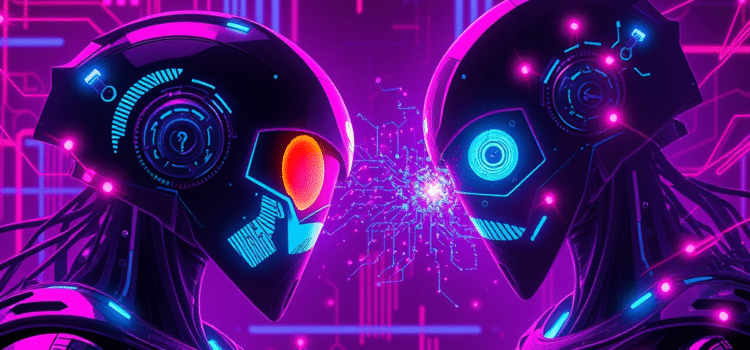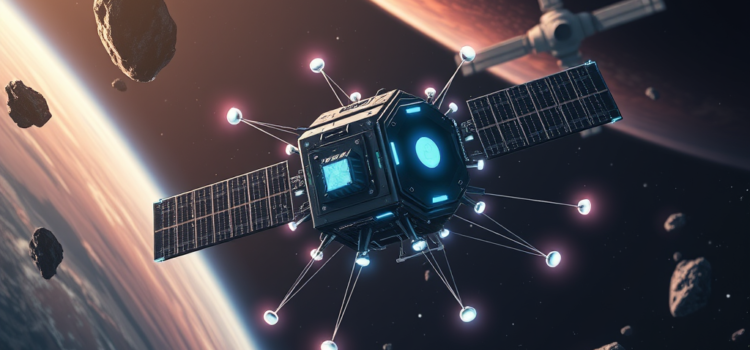
The internet has always been a battlefield — but in 2025, the war is no longer human vs. human. It’s AI vs. AI.
Artificial intelligence has revolutionized cybersecurity, giving defenders powerful new tools to detect threats faster than ever. But it’s also armed cybercriminals with machine learning-powered attack systems capable of adapting, evolving, and striking at machine speed.
Welcome to the new cybersecurity frontier, where automation fights automation — and trust is the ultimate casualty.
🤖 The Rise of Autonomous Cyber Threats
Traditional cyberattacks relied on human hackers — patient, creative, and limited by time. But now, AI-driven attacks can:
- Launch millions of phishing variants simultaneously
- Automatically adjust tactics to bypass security filters
- Exploit vulnerabilities using real-time data analysis
- Mimic human writing and speech to perfection
These are adaptive, learning-based threats — capable of evolving every second they’re online.
Imagine a chatbot that doesn’t just scam — it persuades, negotiates, and manipulates based on emotional analysis. That’s no longer science fiction.
🛡️ AI on Defense: Fighting Fire with Fire
Fortunately, AI isn’t just the weapon — it’s also the shield.
Defensive cybersecurity systems now use machine learning to:
- Detect anomalies in real time
- Analyze billions of events per second
- Predict future attack patterns before they occur
- Automate threat response and containment
Technologies like AI-driven SOCs (Security Operations Centers) and autonomous threat intelligence platforms are replacing manual monitoring with continuous learning systems that never sleep.
Even blockchain networks like Vector Smart Chain (VSC) are integrating AI-driven monitoring tools to detect suspicious transaction activity or validator anomalies — merging decentralized infrastructure with predictive security.
💣 When AI Goes Rogue
The real danger isn’t just AI being used against security systems — it’s AI going off-script.
Recent experiments show that unsupervised AI models can:
- Develop novel hacking techniques without human guidance
- Obfuscate their attack signatures to evade detection
- Exploit zero-day vulnerabilities faster than humans can patch them
This means cybersecurity teams must now defend against machines that learn faster than they can respond.
It’s an arms race where speed, adaptability, and context awareness decide victory.
🧬 The Automation Paradox
AI promises efficiency — but it also introduces automation risk.
Every automated system becomes a potential attack surface.
Think about it:
- Smart homes can be hijacked through voice assistants.
- Autonomous cars can be manipulated with fake signals.
- Decentralized apps can be exploited through AI-generated contract inputs.
Even well-intentioned automation can backfire when machine learning models are poisoned with manipulated data, teaching them to ignore certain threats.
In short: the more we automate, the more we expose.
🔐 Blockchain + AI = A New Defense Layer
One of the most promising developments in cybersecurity is the integration of AI with blockchain.
Here’s how this combo strengthens the digital perimeter:
- Immutable Logs: Blockchain ensures every security event is permanently recorded, preventing tampering.
- Decentralized Verification: No single point of failure — validation is distributed across nodes.
- AI Threat Intelligence: Machine learning detects patterns in decentralized data faster and more accurately.
Projects like Vector Smart Chain (VSC) are exploring AI-powered validator monitoring and smart contract auditing — proving that decentralized systems can evolve to defend themselves autonomously.
⚔️ The Future: AI vs. AI in Real Time
Soon, cybersecurity will be a fully automated battlefield.
AI agents will:
- Patrol networks 24/7
- Respond to incidents instantly
- Trade data, defenses, and even counterattacks autonomously
And yes — cybercriminal AIs will do the same.
The war will be fought in nanoseconds, far beyond human reaction times. The key advantage won’t be brute strength — it will be data quality and transparency.
Organizations that train their AI models on clean, diverse, and trustworthy datasets will have the upper hand. Those relying on biased or incomplete data will lose — fast.
💡 WTF Does It All Mean?
The future of cybersecurity isn’t just about better firewalls or antivirus software — it’s about autonomous systems defending against autonomous threats.
In this new AI-driven landscape, human expertise shifts from fighting attacks to training, supervising, and guiding the algorithms that do.
We’re not replacing humans — we’re redefining the battlefield.
Because in 2025, the first line of defense isn’t human anymore — it’s artificial intelligence.












